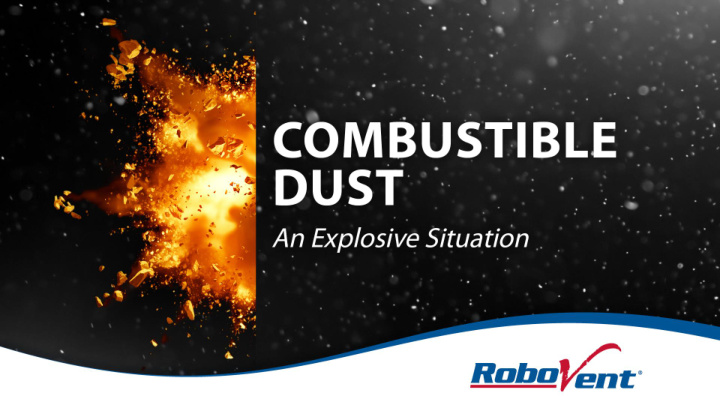



A Major Hazard Difficult to identify • Invisible to the naked eye • Often goes unnoticed •
Combustible Dust Explosions Georgia, 2008. • Sugar Dust Explosions. • 14 killed, 38 injured. • WV, 2010. • Metal Dust Explosion. • 3 killed, 1 injured. •
Combustible Dust Explosions Wisconsin, 2017. • Grain Dust Explosion. • 5 killed, 12 injured. • USA, 2018. • 194 Dust Explosions and Fires • +25% from 2017 •
What Do These Events Have in Common? They can be prevented.
What is Combustible Dust? A collection of fine, solid particles which, either from a single source or in a mixture with other materials, are liable to catch fire or explode upon ignition when dispersed in the air.
Volatility Some can be ignited unexpectedly • (iron dust & water) Measured by ‘ Kst ’ value • The higher the Kst value, the more • severe of an explosion ohsonline.com
The 5 Elements of a Dust Explosion 1. Fuel – The combustible dust 2. Oxidant – Typically the oxygen in the air 3. Ignition Source – Depends on the dust type 4. Dispersion – The accumulation and spread of particles 5. Confinement – Leads to rising pressure and vessel rupture
Deflagration Combustion which propagates through a gas or across the surface of an explosive at subsonic speeds, driven by the transfer of heat. Term used for flash fires and explosions • Flash Fires are Unconfined Deflagration • Explosions are Confined Deflagration •
The Two Explosions Primary Explosion The initial explosion after ignition • Dislodges surrounding dust particles • Secondary Explosion Occurs when dust goes airborne and ignites • This explosion is often more destructive •
Prevention & Mitigation Prevention refers to stopping an incident from occurring • prior to its incipient stages Mitigation refers to protecting workers, equipment or the • environment from an incident after the incipient stages
Prevention & Mitigation Remove Combustible Dust • Proper Hot Work Systems • Concentration Reduction • Avoid Self-Ignition • Oxidizer Reduction • Ignition Source Control • Spark Detection & Control •
Prevention & Mitigation Containment • Venting • Flameless Venting • Suppression Systems •
Consider Testing Your Facility A Dust Hazard Analysis (DHA) will not only determine if there is a significant amount of dust in your facility, but will systematically review and identify the potential for a fire, flash fire and explosion hazards associated with the presence of one or more combustible particulate solids arising from processes in your facilities.
Components of a DHA Methodology & Scope • Material Characterization • Process Characterization • Hard Analysis & Recommendations • Administrative Controls & • Recommendations
Methodology & Scope • No single process works for every situation • One of the most common is Node-Based Node _______________________________________ An environment that has both oxygen and a combustible dust present. A site may have only one such node or it may have nodes reaching into the hundreds.
Material Characterization • Listing materials by maximal pressure • Material source and delivery method must be included in the list • Samples may be taken and tested from materials with multiple or unknown components
Process Characterization • Utilizing the documentation, testing results and a site visit to determine risk factors • Credible ignition sources must be inspected
Hard Analysis & Recommendations • A strategy is formulated to offer mitigation or consistent control of dust in the facility • Information must be clear, concise and be visible to all workers • The report should have the goal to unite everyone in a team effort to make the facility safe
Administrative Controls & Recommendations • The final report should include preventative maintenance recommendations • Includes an emergency planning response procedure for such events
Recap
Recommend
More recommend